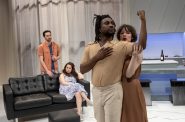The Thrill of Great Music
The Prometheus Trio concert was an uncommonly beautiful performance of four varied works.
I have often wished there were meters in concert halls that measured levels of happiness or well-being on entering and again on exiting. I was feeling rather punk on my way into the Prometheus Trio concert at the Wisconsin Conservatory of Music Tuesday night, but by the time I waltzed out I was a restored human being. Great performances of great music have the power to do just that.
Three inspired artists—pianist Stefanie Jacob, cellist Scott Tisdel, and violinist Margot Schwartz—played a wonderful and varied evening of chamber music by Carter, Mozart, and Tchaikovsky. It was thrilling to attend a performance as uncommonly beautiful as this one was.
With guest performer Schwartz, Tisdel and Jacob opened with a charming version of Elliot Carter’s 1939 Elegy. This piece, arranged for trio by Tisdel, sounded like a musical picture postcard from the very early days of Tanglewood. In the gentle adagio sostenuto, one can almost hear Samuel Barber, Lucas Foss, Leonard Bernstein, Aaron Copland, and others waxing poetic about the critical role of music in life. The open fourths, so prominent in Copland’s music and so haunting to the ear, drifted off as the music gently faded into nothing. The second piece by Carter, Epigrams, was his very last composition, written in 2012—seventy-three years after the Elegy. Gone was the noble Americana flavor, replaced by wryly humorous musical one-liners that, although marked by innocuous musical identifiers such as “quarter note = 72” and “quarter note = 60” and “quarter note = 80,” could just as easily have been given the descriptive titles “Bulldogs barking in the distance” or “You kids stop that!” Each delightful vignette was humorous, and fantastically played.
Mozart’s Trio in B-flat Major, K. 502, written in 1786, represented the opposite end of the compositional spectrum from the two works by Carter. Haydn and Mozart were the innovators of the piano trio: the fortepiano (the precursor to the modern piano) had sonic shortcomings that Haydn recognized right away. With a limited sound in the bass notes and a constricted sound in the upper treble area, adding a cello and a violin to bolster those weaknesses led to compositions for this combination of instruments that would fill libraries with great repertoire. Mozart makes the most of the piano writing in this trio. Jacob gave masterful treatment to the long phrases and technical challenges, and the violin and cello danced along in merry imitation. The opening of the larghetto second movement is a kind of lyrical writing for the piano that you expect to hear from one of Mozart’s tender operatic moments. Again, Jacob cast a spell on the room. The allegretto third movement was a spirited romp over playful phrases. Tisdel and Jacob have played together since they were in graduate school; they know each other’s musical DNA as though it were their own. This must have made Schwartz’s job fitting into the ensemble a lot easier. Schwartz has a big round sound, fluid technique, and a stylishness that is intelligent and mature.
After the intermission, Schwartz’s robust sound was even more fitting in the majestic Trio in A Minor, Opus 50 of Tchaikovsky. The pezzo elegaico: moderato assai gave the trio an opportunity to show off a breathless pianissimo that held the audiencein rapt attention. The theme in the tema con variazioni: andante con moto was introduced in the piano, the violin taking a turn with the cantabile motif and putting a flourish on it. The piano starred in the scherzoso variation with Jacob’s fingers performing technical wizardry. The fifth variation offered an aural surprise: the piano in its upper range over drones in the cello and violin created the sound of an entirely new instrument. While Tisdel played beautifully throughout the evening, the tempo di valse variation showed off his musicianship and full, rich sound. Each variation was more dazzling than the next, and one couldn’t help but be swept away by the great romantic gestures that Tchaikovsky used in this piece. The variazione finale e coda faded away into a sweetly sorrowful nothingness. Tisdel, Jacob, and Schwartz gave a completely satisfying account of this work.
Strangely, Tchaikovsky wrote only one piano trio. It is hard to fathom that this work was all he penned for this combination, particularly considering his tremendous contributions to the concerto repertoire for piano, violin, and cello. However, the Prometheans wrote a delightful arrangement of a Tchaikovsky waltz as an encore, and we all danced off into the night.
Review
-
The Life Story of Gene Wilder
 Apr 8th, 2024 by Dominique Paul Noth
Apr 8th, 2024 by Dominique Paul Noth
-
‘L’Appartement’ Is a Mind-Bending Comedy
 Mar 25th, 2024 by Dominique Paul Noth
Mar 25th, 2024 by Dominique Paul Noth
-
Highlands Café Is Easy to Love
 Mar 15th, 2024 by Cari Taylor-Carlson
Mar 15th, 2024 by Cari Taylor-Carlson



















Well done, Bill. I’m glad and surprised to see you writing about music. Fill the void, bro.
Even though I was there myself and LOVED both the program and the playing, this thoughtful and warmly appreciative review helped me to enjoy it all over again. Great job, Barnewitz
I was also at this performance….it was STUNNING!
For three musicians to cover the ground covered that night was amazing!
I left the concert hall feeling a most satisfied human being.
Thank you, Prometheus!